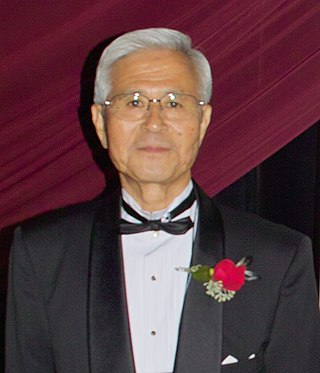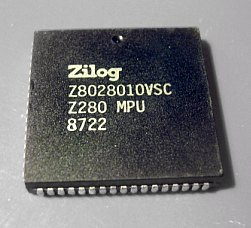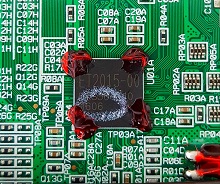
The 6309 is Hitachi's CMOS version of the Motorola 6809 microprocessor, released in late 1982. It was initially marketed as a low-power version of the 6809, without reference to its many internal improvements.

The Intel 8080 ("eighty-eighty") is the second 8-bit microprocessor designed and manufactured by Intel. It first appeared in April 1974 and is an extended and enhanced variant of the earlier 8008 design, although without binary compatibility. The initial specified clock rate or frequency limit was 2 MHz, with common instructions using 4, 5, 7, 10, or 11 cycles. As a result, the processor is able to execute several hundred thousand instructions per second. Two faster variants, the 8080A-1 and 8080A-2, became available later with clock frequency limits of 3.125 MHz and 2.63 MHz respectively. The 8080 needs two support chips to function in most applications: the i8224 clock generator/driver and the i8228 bus controller. It is implemented in N-type metal–oxide–semiconductor logic (NMOS) using non-saturated enhancement mode transistors as loads thus demanding a +12 V and a −5 V voltage in addition to the main transistor–transistor logic (TTL) compatible +5 V.

The Motorola 6809 ("sixty-eight-oh-nine") is an 8-bit microprocessor with some 16-bit features. It was designed by Motorola's Terry Ritter and Joel Boney and introduced in 1978. Although source compatible with the earlier Motorola 6800, the 6809 offered significant improvements over it and 8-bit contemporaries like the MOS Technology 6502, including a hardware multiplication instruction, 16-bit arithmetic, system and user stack registers allowing re-entrant code, improved interrupts, position-independent code and an orthogonal instruction set architecture with a comprehensive set of addressing modes.

The Zilog Z80 is an 8-bit microprocessor designed by Zilog that played an important role in the evolution of early computing. Software-compatible with the Intel 8080, it offered a compelling alternative due to its lower cost and increased performance. The Z80 boasted fourteen registers compared to the 8080's seven, along with additional instructions for bit manipulation, making it a more powerful chip.

Zilog, Inc. is an American manufacturer of microprocessors and 8-bit and 16-bit microcontrollers. It is also a supplier of application-specific embedded system-on-chip (SoC) products.

The Intel 8085 ("eighty-eighty-five") is an 8-bit microprocessor produced by Intel and introduced in March 1976. It is the last 8-bit microprocessor developed by Intel.
The Zilog Z800 was a 16-bit microprocessor designed by Zilog and meant to be released in 1985. It was instruction compatible with their existing Z80, and differed primarily in having on-chip cache and a memory management unit (MMU) to provide a 16 MB address range. It also added a huge number of new more orthogonal instructions and addressing modes.

The Zilog Z8000 is a 16-bit microprocessor designed by Zilog in early 1979.

Masatoshi Shima is a Japanese electronics engineer. He was one of the architects of the world's first microprocessor, the Intel 4004. In 1968, Shima worked for Busicom in Japan, and did the logic design for a specialized CPU to be translated into three-chip custom chips. In 1969, he worked with Intel's Ted Hoff and Stanley Mazor to reduce the three-chip Busicom proposal into a one-chip architecture. In 1970, that architecture was transformed into a silicon chip, the Intel 4004, by Federico Faggin, with Shima's assistance in logic design.

The Zilog Z180 is an 8-bit microprocessor designed by Zilog as a successor to the Z80. It is compatible with the large base of software written for the Z80. The Z180 family adds higher performance and integrated peripheral functions like clock generator, 16-bit counters/timers, interrupt controller, wait-state generators, serial ports and a DMA controller. It uses separate read and write strobes, sharing similar timings with the Z80 and Intel processors. The on-chip memory management unit (MMU) has the capability of addressing up to 1 MB of memory. It is possible to configure the Z180 to operate as the Hitachi HD64180.

The Zilog Z280 is an 16-bit microprocessor designed by Zilog as an enhancement of the Zilog Z80 architecture and integrating improvements from the abandoned Zilog Z800 project. First introduced in July 1987, the Z280 is considered to be a commercial failure.

The Zilog eZ80 is an 8-bit microprocessor designed by Zilog as an updated version of the company's first product, the highly-successful Zilog Z80. The eZ80 is binary compatible with the Z80, but operating almost three times faster at the same clock frequency.

The Zilog Z8 is a microcontroller architecture, originally introduced in 1979, which today also includes the Z8 Encore!, eZ8 Encore!, eZ8 Encore! XP, and eZ8 Encore! MC families.

The U880 is an 8-bit microprocessor that was manufactured by VEB Mikroelektronik "Karl Marx" Erfurt in the German Democratic Republic. Production of the U880 started in 1980 at VEB Funkwerk Erfurt. The U880 is an unlicensed clone of the Zilog Z80 microprocessor, also supporting illegal opcodes and bugs, except for very minor differences like not setting the CY flag for the OUTI command.

The Zilog Z80182 is an enhanced, faster version of the older Z80 and is part of the Z180 microprocessor family. It's nicknamed the Zilog Intelligent Peripheral Controller (ZIP).
TLCS is a prefix applied to microcontrollers made by Toshiba. The product line includes multiple families of CISC and RISC architectures. Individual components generally have a part number beginning with "TMP". E.g. the TMP8048AP is a member of the TLCS-48 family.

The TRS-80 Model 4 is the last Z80-based home computer family by Radio Shack, sold from April 1983 through late 1991.
The NEC μCOM series is a series of microprocessors and microcontrollers manufactured by NEC in the 1970s and 1980s. The initial entries in the series were custom-designed 4 and 16-bit designs, but later models in the series were mostly based on the Intel 8080 and Zilog Z80 8-bit designs, and later, the Intel 8086 16-bit design. Most of the line was replaced in 1984 by the NEC V20, an Intel 8088 clone.
















